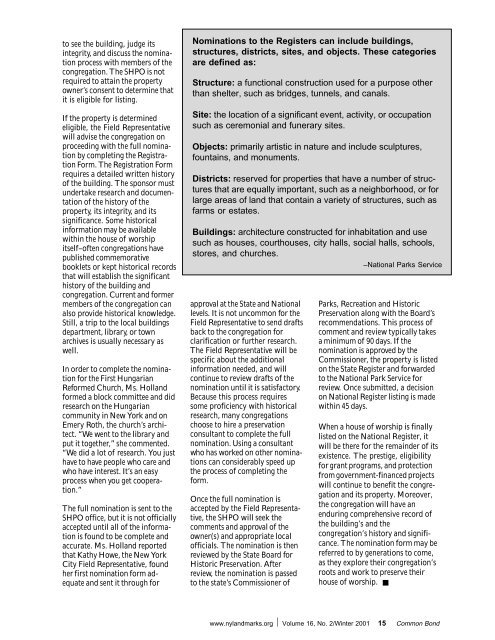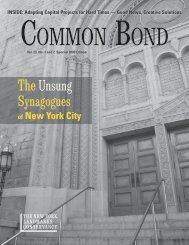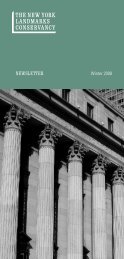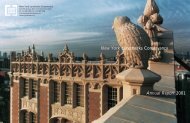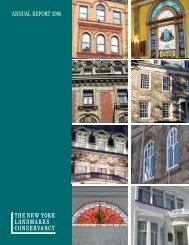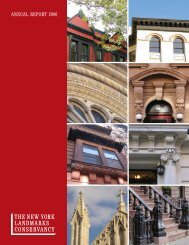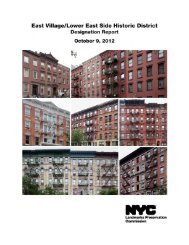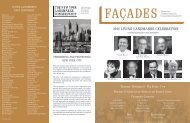Download Common Bond - The New York Landmarks Conservancy
Download Common Bond - The New York Landmarks Conservancy
Download Common Bond - The New York Landmarks Conservancy
You also want an ePaper? Increase the reach of your titles
YUMPU automatically turns print PDFs into web optimized ePapers that Google loves.
to see the building, judge its<br />
integrity, and discuss the nomination<br />
process with members of the<br />
congregation. <strong>The</strong> SHPO is not<br />
required to attain the property<br />
owner’s consent to determine that<br />
it is eligible for listing.<br />
If the property is determined<br />
eligible, the Field Representative<br />
will advise the congregation on<br />
proceeding with the full nomination<br />
by completing the Registration<br />
Form. <strong>The</strong> Registration Form<br />
requires a detailed written history<br />
of the building. <strong>The</strong> sponsor must<br />
undertake research and documentation<br />
of the history of the<br />
property, its integrity, and its<br />
significance. Some historical<br />
information may be available<br />
within the house of worship<br />
itself–often congregations have<br />
published commemorative<br />
booklets or kept historical records<br />
that will establish the significant<br />
history of the building and<br />
congregation. Current and former<br />
members of the congregation can<br />
also provide historical knowledge.<br />
Still, a trip to the local buildings<br />
department, library, or town<br />
archives is usually necessary as<br />
well.<br />
In order to complete the nomination<br />
for the First Hungarian<br />
Reformed Church, Ms. Holland<br />
formed a block committee and did<br />
research on the Hungarian<br />
community in <strong>New</strong> <strong>York</strong> and on<br />
Emery Roth, the church’s architect.<br />
“We went to the library and<br />
put it together,” she commented.<br />
“We did a lot of research. You just<br />
have to have people who care and<br />
who have interest. It’s an easy<br />
process when you get cooperation.”<br />
<strong>The</strong> full nomination is sent to the<br />
SHPO office, but it is not officially<br />
accepted until all of the information<br />
is found to be complete and<br />
accurate. Ms. Holland reported<br />
that Kathy Howe, the <strong>New</strong> <strong>York</strong><br />
City Field Representative, found<br />
her first nomination form adequate<br />
and sent it through for<br />
Nominations to the Registers can include buildings,<br />
structures, districts, sites, and objects. <strong>The</strong>se categories<br />
are defined as:<br />
Structure: a functional construction used for a purpose other<br />
than shelter, such as bridges, tunnels, and canals.<br />
Site: the location of a significant event, activity, or occupation<br />
such as ceremonial and funerary sites.<br />
Objects: primarily artistic in nature and include sculptures,<br />
fountains, and monuments.<br />
Districts: reserved for properties that have a number of structures<br />
that are equally important, such as a neighborhood, or for<br />
large areas of land that contain a variety of structures, such as<br />
farms or estates.<br />
Buildings: architecture constructed for inhabitation and use<br />
such as houses, courthouses, city halls, social halls, schools,<br />
stores, and churches.<br />
–National Parks Service<br />
approval at the State and National<br />
levels. It is not uncommon for the<br />
Field Representative to send drafts<br />
back to the congregation for<br />
clarification or further research.<br />
<strong>The</strong> Field Representative will be<br />
specific about the additional<br />
information needed, and will<br />
continue to review drafts of the<br />
nomination until it is satisfactory.<br />
Because this process requires<br />
some proficiency with historical<br />
research, many congregations<br />
choose to hire a preservation<br />
consultant to complete the full<br />
nomination. Using a consultant<br />
who has worked on other nominations<br />
can considerably speed up<br />
the process of completing the<br />
form.<br />
Once the full nomination is<br />
accepted by the Field Representative,<br />
the SHPO will seek the<br />
comments and approval of the<br />
owner(s) and appropriate local<br />
officials. <strong>The</strong> nomination is then<br />
reviewed by the State Board for<br />
Historic Preservation. After<br />
review, the nomination is passed<br />
to the state’s Commissioner of<br />
Parks, Recreation and Historic<br />
Preservation along with the Board’s<br />
recommendations. This process of<br />
comment and review typically takes<br />
a minimum of 90 days. If the<br />
nomination is approved by the<br />
Commissioner, the property is listed<br />
on the State Register and forwarded<br />
to the National Park Service for<br />
review. Once submitted, a decision<br />
on National Register listing is made<br />
within 45 days.<br />
When a house of worship is finally<br />
listed on the National Register, it<br />
will be there for the remainder of its<br />
existence. <strong>The</strong> prestige, eligibility<br />
for grant programs, and protection<br />
from government-financed projects<br />
will continue to benefit the congregation<br />
and its property. Moreover,<br />
the congregation will have an<br />
enduring comprehensive record of<br />
the building’s and the<br />
congregation’s history and significance.<br />
<strong>The</strong> nomination form may be<br />
referred to by generations to come,<br />
as they explore their congregation’s<br />
roots and work to preserve their<br />
house of worship. n<br />
www.nylandmarks.org ⏐ Volume 16, No. 2/Winter 2001 15 <strong>Common</strong> <strong>Bond</strong>


